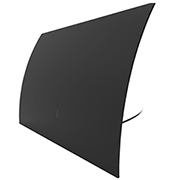AARP Hearing Center


Dumping expensive cable and satellite services, so-called cord cutting, isn’t just for millennials.
Plenty of people are discovering that they can get all the video and TV programming they want while they shelter in place — and most of it for free, over the air. A slew of free stations even are aimed specifically at those of us who remember who Mrs. Beasley was and where Laura Petrie lived. (For those who don’t, you’ll find the answers at the end of this article.)
Over-the-air networks
ABC, CBS, NBC and PBS may be the networks you first think of when you hear the words “broadcast TV.” But The CW, Fox and MyNetworkTV also reach almost all U.S. households. Some others with wide over-the-air reach:
• Antenna TV, classic TV series, movies
• Bounce TV, African American programming
• Comet, science fiction
• Court TV, true crime, court news
• Court TV Mystery, suspense, drama
• Cozi TV, classic series, movies, lifestyle
• Dabi, lifestyle programming
• GetTV, classic TV series, movies
• Grit, action, Western shows
• Ion, general entertainment, paid programs
• Justice Network, true crime
• Laff, comedy
• MeTV, classic TV series
• This TV, classic TV series, movies
• Univision, Spanish-language programs
To replace cable TV, most people think of streaming services such as Amazon Prime Video and Netflix. But those services don’t offer live news coverage, local TV stations, or sporting events. For that, you need to tune in over-the-air TV channels.
Fortunately, free over-the-air broadcasts have continued through the years, and since 2009 they’ve been available in digital, high-definition form. These aren’t the static-filled broadcasts of yesteryear. These are crystal clear local network TV stations from the likes of ABC, CBS, NBC and PBS in full 1080-pixel high def.
Because they are digital, more TV channels can be squeezed into the same spectrum. Many local channels now offer several substations.
Local Channel 2 may offer channels 2.1, 2.2 and 2.3 as well. Usually these substations are in standard definition and feature nostalgia channels, such as Antenna and Grit, with reruns of shows like Leave It to Beaver and Gunsmoke.
Best of all, to watch these shows you don’t have to wrestle with the finicky rabbit ear antennas of yore. You can easily tune them in with the right digital antenna.
How to find free TV
Most TVs manufactured after 2006, but not all, have built-in digital tuners to receive over-the-air broadcasts. For example, several popular Vizio flat screens from a couple of years ago eliminated the tuners; Vizio added them back later.
To doublecheck your own set, go to the “inputs” section of your TV’s on-screen settings. If it has an option for TV broadcasts, your set has a tuner.
What TVs generally lack is an antenna, so you’ll need to purchase one. Fortunately, antennas are relatively inexpensive. Some cost a little more than $10 for a small indoor model.
However, if you’re in a suburban area far from broadcast towers, you may need a large outdoor model, which can cost up to $200. After testing scores of antennas over the years, I’ve learned some simple steps to choose the right antenna for your situation.
To begin, check to see what stations are broadcasting in your area. In an urban area like New York City, you may have access to more than 60 stations, while rural areas won’t be able to receive any stations.




































































More on home-family
How to Bring Web Video, Home Movies to a Big-Screen TV
A step-by-step guide for communicating among devices
Supersize Your Home Theater With This Gear
No matter your budget, you can upgrade your family room setupSimple Tips to Improve Your TV Viewing Experience
Great home theater accessories don't guarantee clarity of picture, sound